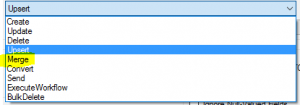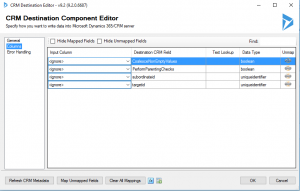Verweise:
//KingswaySoft.DynamicsCrmServices //Pfad: C:\WINDOWS\assembly\GAC_MSIL\KingswaySoft.DynamicsCrmServices\1.0.0.0__705df8e0751bcea7\KingswaySoft.DynamicsCrmServices.dll //KingswaySoft.IntegrationToolkit.DynamicsCrm //Pfad: C:\Program Files (x86)\Microsoft SQL Server\120\DTS\PipelineComponents\KingswaySoft.IntegrationToolkit.DynamicsCrm.dll
Namespaces im Code:
using KingswaySoft.DynamicsCrmServices.Soap2011.OrganizationService; using KingswaySoft.DynamicsCrmServices.Soap2011.OrganizationService.Messages; using KingswaySoft.DynamicsCrmServices.Soap2011.OrganizationService.Metadata; using KingswaySoft.DynamicsCrmServices.Soap2011.OrganizationService.Query; using KingswaySoft.IntegrationToolkit.DynamicsCrm;
Code:
public override void Input0_ProcessInputRow(Input0Buffer Row)
{
/*
* Add your code here
*
* http://www.kingswaysoft.com/blog/2013/06/24/Writing-Script-Component-or-Script-Task-using-CRM-Connection-Manager
*/
//var connMgr = this.Connections.Dynamics365;
//var conn = (CrmConnection)connMgr.AcquireConnection(null);
var connMgr = this.Connections.Dynamics365;
var connectionString = (string)connMgr.AcquireConnection(null);
var conn = new CrmConnection(connectionString);
var orgService = (IOrganizationService)conn.GetCrmService();
//Select parentcustomerid from contact where contact = '00000-0000000000-00000-00000-0000'
var inputValue = Row.contactid; // input0: Field "contactid"
var retrievedEntity = orgService.Retrieve("account", parmInputvalue, new ColumnSet("parentcustomerid"));
var outputValue = retrievedEntity.GetAttributeValue("parentcustomerid");
Row.parentcustomerid = outputValue; // output0: new Field "parentcustomerid"
}
</pre








